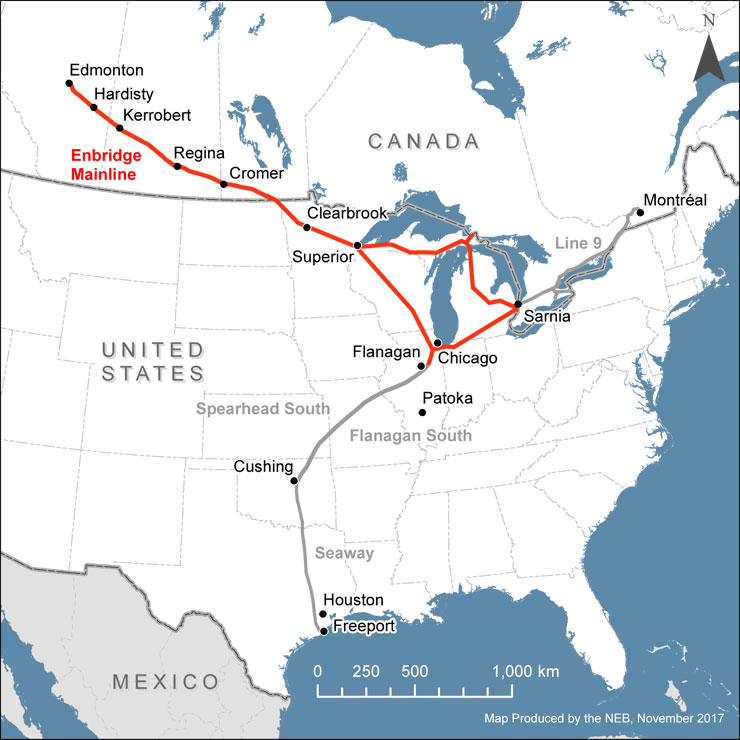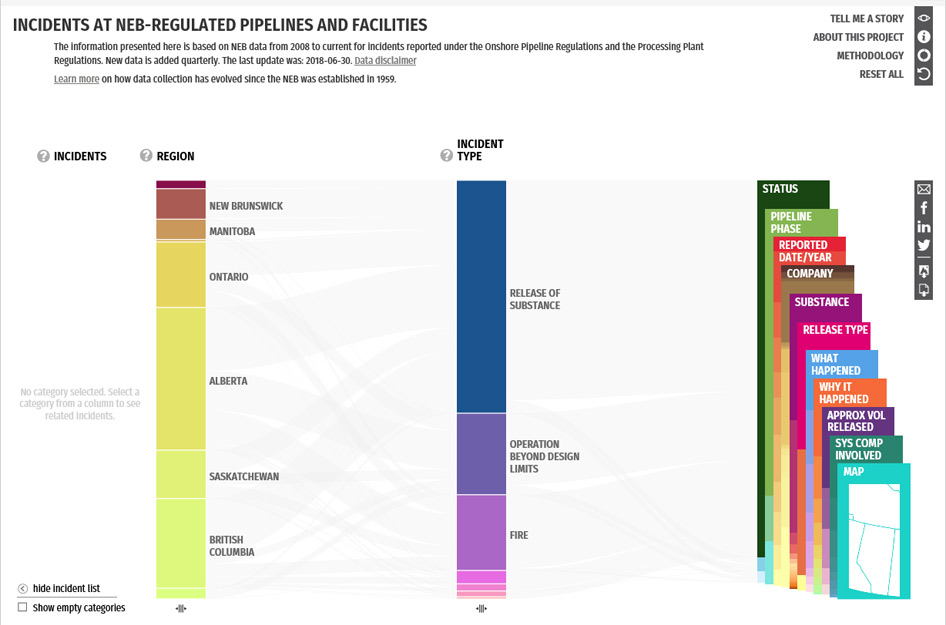Energy Information
The NEB collects, monitors, analyzes and publishes information on energy markets and supply, sources of energy, and the safety and security of pipelines and international power lines.
Our Commitment
Canadians have access to and use energy information for knowledge, research and decision making, access to community-specific NEB-regulated infrastructure information, and opportunities to collaborate and provide feedback on NEB information products.
The NEB plays a vital role in conveying objective and unbiased information to Canadians and the world. Rapidly changing energy markets and the need for climate policy development have also made this information more essential than ever. Technical staff at the NEB conduct extensive research and collaborate with various public, academic and not-for-profit organizations to produce balanced and thorough analysis of Canadian energy trends. We also provide Canadians information about pipeline infrastructure and safety at the community and regional level.
Energy Information Activity in 2017-18:
-
 49 Market Snapshots
49 Market Snapshots -
 8 new publications
8 new publications -
 Nearly 1,000,000 unique Energy and Pipeline Information page views
Nearly 1,000,000 unique Energy and Pipeline Information page views
Energy Information
Number of times NEB energy information is accessed.
- Target 750,000
- Results
2016-17 879,831 - Results
2017-18 986,347
Percentage of surveyed web users who agree that energy information is useful for knowledge, research or decision making.
- Target 75%
- Results
2016-17 No Results - Results
2017-18 84%
Tracking the number of unique external page views helps us determine how frequently this information is accessed. The number of users accessing the NEB’s online Energy Information grew by 12% in 2017-18, driven by new and innovative types of energy information products. Significant viewer gains were achieved by the NEB’s new Pipeline Profiles, Interactive Pipeline Map, and data visualizations, along with updates of the well-received Energy Futures and Canada’s Renewable Power Landscape reports.
This is an indicator of the public’s appetite for more information about Canada’s energy systems, and the NEB’s ability to meet that demand creatively and efficiently. We continue to explore new offerings to ensure that the positive contributions we make to Canadian energy information continually evolve and improve.
One of the most-used products released by the NEB last year were our Pipeline Profiles, an interactive online tool that provides Canadians with easy-to-use information on what has been shipped on most major NEB-regulated pipelines since 2006. The profiles include detailed information on key statistics, developments, utilization, reported daily throughputs, tolls and financial data and international export/import points.
Pipeline System and key points
 Updated December 2017
Updated December 2017
The Enbridge Mainline system is Canada’s largest transporter of crude oil, moving Western Canadian crude oil production to markets in eastern Canada and the U.S. Midwest. The Mainline also transports refined petroleum products to Saskatchewan and Manitoba and natural gas liquids to Sarnia, Ontario. The first leg of the Mainline from Edmonton, Alberta to Superior, Wisconsin was built in 1950. In 1953 it was extended to Sarnia, Ontario. The Mainline has been expanded and upgraded during the last thirty years to its current configuration and capacity.
The Mainline originates in Edmonton, Alberta and extends east across the Prairies. It receives western Canadian and U.S. crude oil from feeder pipelines at Kerrobert and Regina in Saskatchewan and Cromer in Manitoba. The pipeline crosses the Canada-U.S. border near Gretna, Manitoba, where it joins with the Enbridge Lakehead system.
Energy Systems Information products released in 2017-18:
- Market Snapshots – published weekly
- Pipeline Profiles – data updated quarterly, plus other periodic updates
- Canada’s Renewable Power Sources (May 2017)
- Canada’s Role in the Global LNG Market (July 2017)
- Energy Futures (October 2017)
- Duvernay Resource Assessment and Duvernay Shale Economic Resources (September and November 2017)
- Canada’s Renewable Power Landscape (December 2017)
- Provincial & Territorial Energy Profiles (December 2017)
- Energy Futures Supplements (January 2017)
- Various Market Snapshots (Maritime’s Gas Price Regulation, GHG Emissions from Residential Electricity Consumption, Canadian Innovations in the Energy Sector, etc.)
- Statistics (ongoing updates)
Meaningful public input on Energy Information
NEB’s Energy Information programs are only as good as the data we collect and the need for the information we produce. We want to provide Canadians with the most useful energy and pipeline safety information possible.
We are meeting our targets in terms of unique web hits and user satisfaction. However, finding ways to gather feedback and understanding audience interests and needs remains a challenge. NEB staff are exploring ways to better engage with users to ensure they have access to the pipeline safety and energy market information they need for their knowledge, research, and decision making. In the coming year, the NEB will conduct focus groups to collect a more in-depth understanding of how the public uses our information
Over 2017-18, the NEB published new, community-based pipeline information, related to pipeline traffic, capacity, import/ export points, safety orders, and select route maps. We also explored new ways of making that information more accessible, interactive and meaningful to users, through tools like data visualizations.
One important visualization developed and released last year related to providing Canadians with information in an easy-to-use format on incidents. It allows users to click on different data points and filter data to view incident data based on user preferences.

Increased information specific to National Energy Board-regulated infrastructure in communities, to ensure more local information about NEB-regulated pipelines is available to the public.
- Target 5 new data sets
- Results
2016-17 7 - Results
2017-18 5
Number of opportunities that Canadians have to collaborate and provide feedback on energy information products, to track stakeholder input into the design and development of energy information products.
- Target 42
- Results
2016-17 No Results - Results
2017-18 76
Energized Collaboration
Energy system knowledge is a vast field that is informed by geographic perspectives, unique data repositories, and multiple disciplines. Participating in a broader network and actively seeking input and ideas from other energy-related organizations enables us to learn, share and pursue continual improvement in our Energy Information programs.
The NEB has met with stakeholders more than 70 times in the past year to discuss, consult on, and sometimes partner in the development of energy information products. Collaborations occur with organizations ranging from provincial and territorial governments across Canada, to various academic, non-profit, and industry organizations, and international bodies such as the US Federal Energy Regulatory Commission and the International Energy Agency.

Performance Summary for Energy Information and Next Year’s Focus
- We will continue to contribute to Canada’s energy dialogue by offering the unique information, analysis and perspective of the regulator, as a distinct, integral part of our mandate.
- We will continue to integrate Energy Systems Information and Pipeline Information to offer Canadians a big-picture view of how energy markets, trade, infrastructure and development intersect.
- We will continue to publish high-quality products by proactively seeking audience feedback and engaging users on their experiences, utilizing intensive techniques like focus groups to capture deeper insight into preferences and needs.
- We will develop and release large-scale data visualizations on imports/exports and compliance conditions as a part of our commitment to provide Canadians with transparent access to regulatory data.

